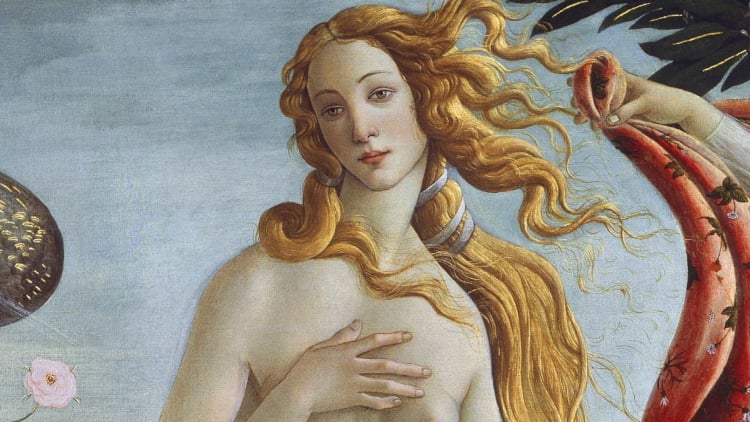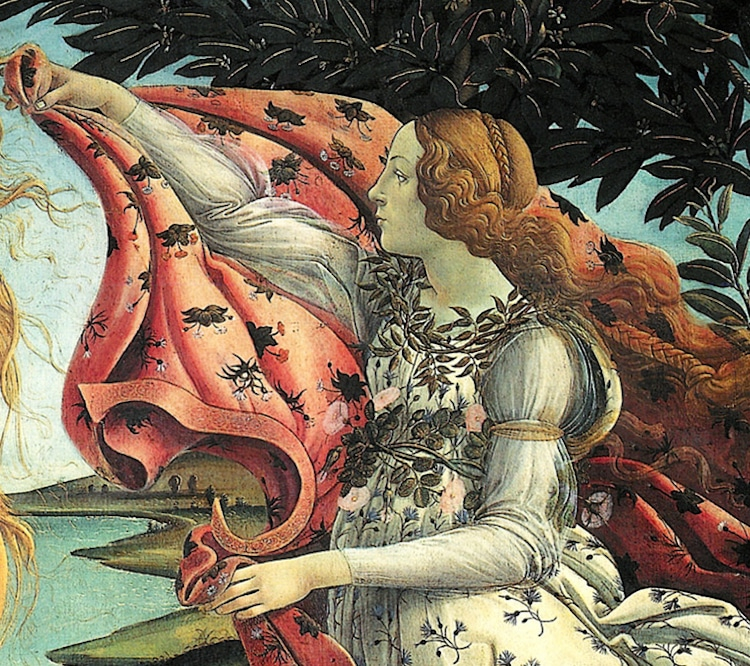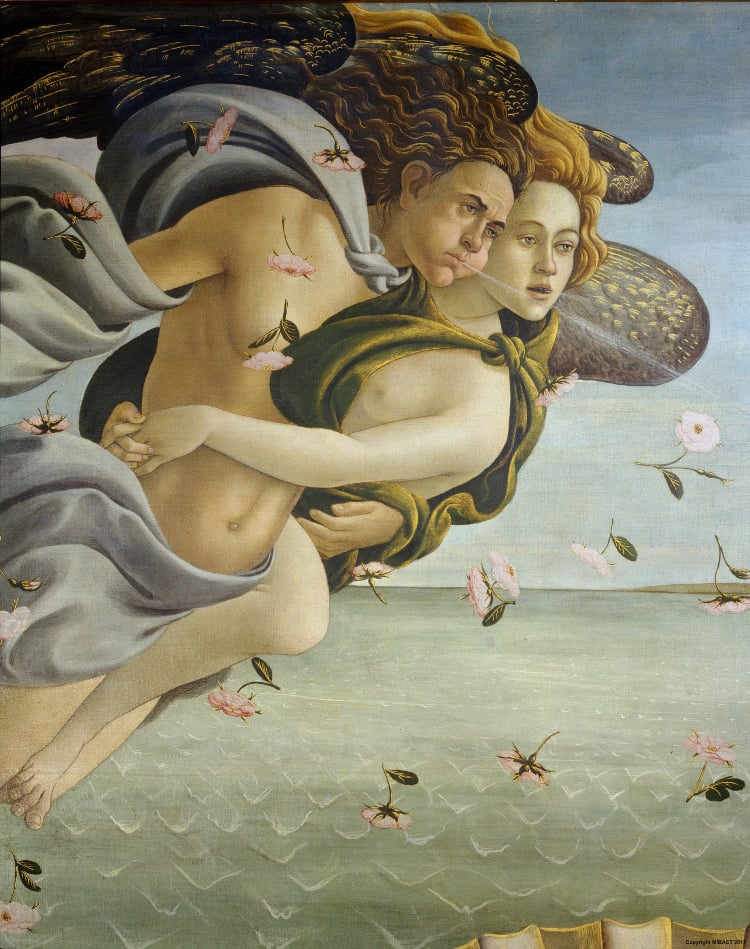Beauty and Myth | The Birth of Venus by Sandro Botticelli
The Renaissance was one of the greatest periods of creative and intellectual achievement in world history. It was an extraordinary upsurge of learning and artistic activity that spread throughout Europe in the 15t?h ?and 16th centuries. It was inspired by the literature, language, culture and art of Classical Greece and Rome. Neo-Platonism and humanism were major parts of the early renaissance; they were key elements that valued human achievements and celebrated human beings. Appreciation of beauty was also a focal point of the new Renaissance.
Beauty in all things was thought to have deep inner virtue and was therefore essential in the path towards God. The early Renaissance was the rebirth of classical values. It was evident that mythology and symbolism were two major concerns of the painter Sandro Botticelli. Although these two elements were at the heart of his work, Botticelli also loved the idealism of women. He believed beyond natural beauty. He expressed women that were perfect.

Born in 1445 in Italy, and died in 1510, he was the next great painter after Masaccio, but his work was very different. Botticelli focused more on the idealism of the female figure, along with mythology and symbolism in his secular pieces. He was very skilled at drawing moving figures. He created very elegant paintings with flowing figures and an appreciation of the female form.
Initially, he trained as a goldsmith with his brother Antonio, who raised Botticelli and gave him the nickname ‘Botticelli’, meaning little barrel. By around 1462, he was apprenticed by Fra Filippo Lippi, who taught Botticelli about his now most recognised characteristic; idealism and the slightly melancholic image of female beauty. This wistful beauty is also found in Lippi’s ‘Madonna and Child’.

Botticelli was greatly influenced by Masaccio and the tapestries of the Pollaiuolo brothers. By 1470, he had his own workshop and was patronised by the Medici family, where he was a great favourite of Lorenzo the Magnificent. In the Medici Palace, he studied the revised work of Plato, a 3rd century Greek philosopher who believed in truth, and how beauty and beautiful things were closer to god. Botticelli painted both religious and secular works, portraying women as incredible beauties. His style is characterised by a great ability to draw the human figure with clear outlines. He used a brown line to surround all of his figures, that are elegantly weightless yet solid.
The Birth of Venus was painted in 1484. It was painted with tempera on canvas, a popular and cheap choice for secular work. The canvas was a less expensive painting surface than the wooden panels used in church and court pictures. A wooden surface would have been impractical for a piece of this scale. Canvas is known to have been the preferred material for painting of secular and pagan subjects.
The painting depicts the image of Venus being blown gently to shore on a shell by a Zephyr and Chloris. She lands on the island of Cyprus. In this mythical story, it is said that Venus was born as a fully-grown woman. She was conceived when the Titan Cronus castrated his father, the god Uranus. The severed genitals fell into the sea, fertilising it. Venus was believed to be a woman who represented the idealised version of woman. Botticelli paints her like a statue. It is said that he gained inspiration from statues in the Medici gardens.
Venus in her shell is the focus of the painting. She stands in the contrapposto pose with her leg slightly bent and one foot slightly up. Her pose is modest as she is aware of her nakedness, while her body is completely elongated and idealised. Her face is one of the most beautiful faces in art history and is said to have been modelled from a mistress of the Medicis, with whom Botticelli was believed to have been in love. Venus is idealised as a beauty but also as a religious figure.

Roses with golden centres fall around her to symbolise her status and importance. To the right of Venus, there is a nymph of Spring. She is believed to be either Horae, the Goddess of seasons, or Hora, the Goddess of Spring. She is rushing to Venus with a beautiful floral cloak to cover her nakedness. The Goddess has a weightless, graceful beauty.
The flowers on her dress symbolise birth and the myrtle around her neck symbolises Venus. Both her lavishly decorated dress and delicate robe she holds out to Venus are embroidered with red and white daisies, yellow primroses and blue cornflowers. All of these Spring flowers are appropriate to the theme of birth. The cloak creates a frame of the coastline. The wooded shore and trees behind her form part of a flowering orange grove, which is a symbol of the Medici family. Each white blossom is tipped with gold, which is used throughout the painting to accentuate its role as a precious object, and to echo the divine status of Venus.

Each dark green leaf has a gold spine and outline. The tree trunks are highlighted with short diagonal lines of gold. Venus is standing on a shell. This creates a three-dimensional effect, as the water appears to be foaming under it. The pattern of the waves looks quite childlike. Botticelli creates great atmospheric perspective by painting the sea darker near the shore.
To the left of Venus there is a Zephyr and Chloris. The Zephyr which represents the cold north wind and Chloris, who also represents Spring, fly with limbs entwined. Their wings are modelled from birds’ wings. The Zephyr blows a cold wind on Venus while the Nymph blows a warmer air.

There is both realism and decoration in the painting as Botticelli adopts a more decorative style. His gentle use of paint creates form, volume and gentleness in the face. Botticelli uses very rich colours that contrast beautifully. The golden hair of the woman stands out magnificently against their pale skin. The rich blue of the Zephyrs cloak works simultaneously with his skin, brown hair and rich shades of blue and green in the sky, sea and land. The divine red cloak immediately draws the eye in.
Mythology and symbolism are considered to be the two main concerns of Botticelli. However, the idealism of the female figure and his love of the perfect woman is at the heart of his work. As seen in his paintings, Botticelli created the most perfect, idealistic woman from his muse, the mistress of the Medicis into the flawless Venus.
